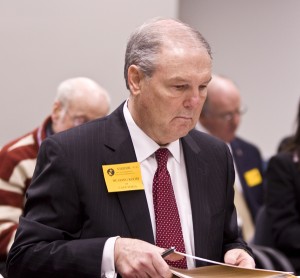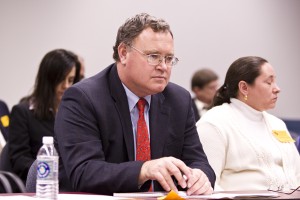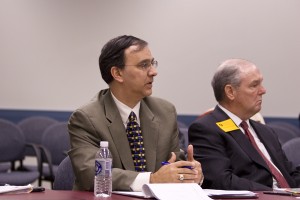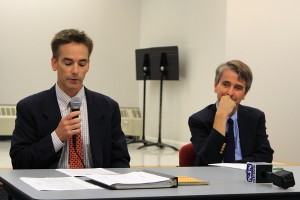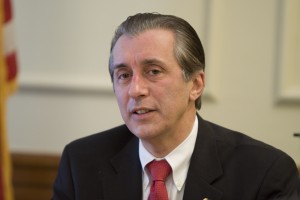DEP Adopts Clean Air Rule – Rejects Oil Industy Opposition
Corzine Clean Air Proposal Survives Christie Red Tape Review and Cost Benefit Tests
[Update: I’d like to clarify an important point I left implicit in the initial post. In a March 8, 2010 post, I posed the question:
So what’s it going to be?
Will DEP be allowed to adopt the science based rule they proposed mandating reductions to 500 ppm by 2014 and 15 ppm by 2016?
Or will oil industry lobbying of the Regulatory Czar Guadagno block all or part of the DEP proposal?
Dena Mottolla of Environment NJ and I attended and spoke forcefully at the “Stakeholders meeting” on these rules. By attending the meeting, offering up policy and political arguments in support of the rule, and writing about the oil industry lobbying threat (which no mainstream media outlets did), we like to think we helped get the word out, galvanize public opposition, and stiffen the spine of DEP Commissioner Martin. This is what sound advocacy backed by accountability can accomplish. Kudos also to Environment NJ for their organizing effort].
DEP Commissioner Bob Martin announced today that DEP adopted last year’s Corzine administration proposal to lower the sulfur content of fuel oil.
The rules are an important component of NJ’s clean air strategy. They were supported by US EPA and environmental groups, and were strongly opposed by the oil industry.
The proposal was frozen by Governor Christie’s Executive Order #1 90 day regulatory moratorium, reviewed by the Red Tape Review Group, and subject to a “Stakeholder review”, new cost benefit analysis, and other so called “common sense regulatory principles” mandated under Executive Order #2.
The move bolsters Martin’s independence from Lt. Governor Guadagno, who could have blocked the proposal.
Adoption of the rule as proposed also validates DEP’s professionals, who proposed a science based rule whose public health benefits far exceeded industry compliance costs.
The adoption extinguishes a threat to the rule, which I wrote about on March 8 during the moratorium, in:”Oil Industry Seeks Clean Air Rollback Under Christie Moratorium:
Today, DEP held a stakeholders meeting to discuss another important clean air rule blocked by the moratorium. Keeping with the war metaphor, let’s call this one subject to extraordinary rendition to a black site somewhere in the Lt. Gov.’s Office.
This particular clean air rule applies to fuel oil and has been under development for over 5 years. It is part of a regional air pollution control strategy endorsed by 11 northeastern and mid-Atlantic states. DEP amended its EPA approved State Implementation Plan (SIP) required under the federal Clean Air Act to incorporate this strategy and set of rules back on June 16, 2008. After much delay, on November 16, 2009, DEP finally proposed new rules that would mandate steep reductions in the concentration of sulfur in fuel oil sold in NJ.
So the oil industry has known this is coming for a long time.
Those fuel oil content reductions are required to reduce air pollution emissions to meet health based standards set under the federal Clean Air Act (see: 40 CFR 51.1002(c)(1).) Those national air quality standards were required to be met by NJ in 2010. There is no debate that the DEP proposal is technologically feasible to meet. In fact, there is pending legislation (A1054 (McKeon)/S1414 (Smith) that would mandate steeper and quicker reductions than those sought by DEP, by imposing the 15 ppm standard by 2011. The DEP rule proposal would mandate a 67% reduction in allowable sulfur, to 500 parts per million by the year 2014, and a sharper 99% reduction to 15 ppm by 2016. The proposal would have dramatic public health benefits, including reducing mortality (i.e. death).
But, not so fast. Huge Oil industry profits are at stake.
To the applause of lobbyists for oil giants Exxon-Mobil, Hess, Conoco Phillips, and backed by cheer-leading of lobbyists for the American Petroleum Institute and the NJ Petroleum Council, the Christie moratorium has thrown a monkey-wrench into the process, disrupting years of work across the mid-Atlantic and New England region.
Despite multi-billion record profits in the oil industry, these giant corporate polluters don’t want to spend money to reduce the death rate their products cause in NJ.
The public health stakes are huge – thus the inflammatory but accurate headline. But there really are lives at stake. Here’s why DEP is requiring that sulfur be reduced: (see page 18-20 of the DEP proposal)
The health effects associated with exposure to fine particles are significant, mainly due to the fact that particles of this size can easily reach into the deepest regions of the lungs.
Significant health effects associated with fine particles exposure include:
- Premature mortality;
- Aggravation of respiratory and cardiovascular disease;
- Decreased lung function and difficulty breathing;
- Asthma attacks; and
- Serious cardiovascular problems, such as heart attacks and cardiac arrhythmia.
The USEPA estimated that attainment of the 1997 annual and daily fine particles standards nationally would prolong tens of thousands of lives each year and prevent hundreds of thousands of hospital admissions, doctor visits, absences from work and school, and respiratory illnesses in children. Individuals particularly sensitive to fine particles exposure include older adults, people with heart and lung disease, and children. The elderly have been shown to be particularly at risk for premature death from the effects of particulate matter. Health studies have shown that there is no clear threshold below which adverse effects are not experienced by at least certain segments of the population. Some individuals who are particularly sensitive to fine particles exposure may even be adversely affected by concentrations of fine particles below the revised 2006 annual and daily standards. (72 Fed. Reg. 20586-20587 (April 25, 2007), Clean Air Fine Particle Implementation Rule) The USEPA is currently reconsidering those standards based on recommendations of its Clean Air Scientific Advisory Committee (CASAC).
According to the most recent Federal and State estimates, 765,125 New Jersey residents have asthma. In 2004, asthma sufferers in New Jersey accounted for 15,679 hospitalizations, which represents approximately one out of every 50 hospitalizations. Of these asthma hospitalizations, 5,175, or about one-third, were children. There were 1,838 deaths due to asthma between 1989 and 2003 in New Jersey. The risk of death from asthma increases considerably with age, with the over-65 population having the highest rates. (see: Asthma in New Jersey Annual Update 2006. New Jersey Department of Health and Senior Services, August 2006 (click on this for document)
SO2 causes a wide variety of health and environmental impacts because of the way it reacts with other substances in the air. SO2 reacts with other chemicals in the air to form fine sulfate particles. When these are breathed, they gather in the lungs and are associated with increased respiratory symptoms and disease, difficulty in breathing, and premature death. Peak levels of SO2 in the air can cause temporary breathing difficulty for people with asthma who are active outdoors. Longer-term exposures to high levels of SO2 gas and particles cause respiratory illness and aggravate existing heart disease. (Sulfur Dioxide: Health and Environmental Impacts of SO2/Six Common Pollutants/Air & Radiation/USEPA. (click on this for document).
Increased ozone concentrations severely affect the quality of life for susceptible populations: children, the elderly, and asthmatics and present health risks for everyone. Exposure to ozone for several hours at relatively low concentrations significantly reduces lung function and induces respiratory inflammation in normal, healthy people during exercise. This decrease in lung function is generally accompanied by symptoms such as chest pain, coughing, sneezing, and pulmonary congestion. (The Green Book Nonattainment Areas for Criteria Pollutants, United States Environmental Protection Agency, as updated August 17, 2007. Click on this for document)
NOx, as a precursor for both fine particles and ozone, will contribute to the health impacts associated with both fine particles and ozone. Ozone exposure can cause several health effects, including irritation of lungs. This can make the lungs more vulnerable to diseases such as pneumonia and bronchitis, increase incidents of asthma and susceptibility to respiratory infections, reduce lung function, reduce an individual’s ability to exercise and aggravate chronic lung diseases.
In addition to these incredible public health benefits, even the cost benefit analysis on the rule documented HUGE net economic benefits, due mainly to all the avoided costs of health care.
So what’s it going to be?
Will DEP be allowed to adopt the science based rule they proposed mandating reductions to 500 ppm by 2014 and 15 ppm by 2016?
Or will oil industry lobbying of the Regulatory Czar Guadagno block all or part of the DEP proposal?
The ball is in Regulatory Czar Guadagno and ultimately Governor Christie’s court
To paraphrase DEP air quality experts: If this rule proposal doesn’t pass muster under the Governor’s Executive Order review process, none will
